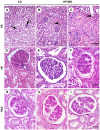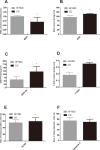A Long-Term High-Fat/High-Sucrose Diet Promotes Kidney Lipid Deposition and Causes Apoptosis and Glomerular Hypertrophy in Bama Minipigs
- PMID: 26571016
- PMCID: PMC4646641
- DOI: 10.1371/journal.pone.0142884
A Long-Term High-Fat/High-Sucrose Diet Promotes Kidney Lipid Deposition and Causes Apoptosis and Glomerular Hypertrophy in Bama Minipigs
Abstract
Metabolic syndrome can induce chronic renal injury in humans. In the present study, Bama minipigs were fed a high-fat/high-sucrose diet (HFHSD) for 23 months, which caused them to develop the pathological characteristics of metabolic syndrome, including obesity, hyperinsulinemia, and hyperlipidemia, and resulted in kidney tissue damage. In the HFHSD group, the ratio of the glomus areas to the glomerulus area and the glomerular density inside the renal cortex both decreased. Lipid deposition in the renal tubules was detected in the HFHSD group, and up-regulated expression levels of SREBP-1, FABP3 and LEPR promoted lipid deposition. The decreased levels of SOD, T-AOC and GSH-PX indicated that the antioxidant capacity of the renal tissues was diminished in the HFHSD group compared with MDA, which increased. The renal tissue in the HFHSD group exhibited clear signs of inflammation as well as significantly elevated expression of key genes associated with inflammation, including tumor necrosis factor-α (TNF-α) and macrophage migration inhibitory factor (MIF), compared with the control group. The tubular epithelial cells in the HFHSD group displayed significantly greater numbers of apoptotic cells, and the expression of proliferating cell nuclear antigen (PCNA) in the renal tubules decreased. Caspase-3 expression increased significantly, and the transcription factor nuclear factor κB (NF-κB) was activated and translocated into the nucleus. In conclusion, long-term HFHSDs cause metabolic syndrome and chronic renal tissue injury in Bama minipigs. These findings provide a foundation for further studies investigating metabolic syndrome and nephropathy.
Conflict of interest statement
Figures






Similar articles
-
Long-term High-fat High-sucrose Diet Promotes Enlarged Islets and β-Cell Damage by Oxidative Stress in Bama Minipigs.Pancreas. 2015 Aug;44(6):888-95. doi: 10.1097/MPA.0000000000000349. Pancreas. 2015. PMID: 25906446
-
Global Transcriptomic Profiling of Cardiac Hypertrophy and Fatty Heart Induced by Long-Term High-Energy Diet in Bama Miniature Pigs.PLoS One. 2015 Jul 10;10(7):e0132420. doi: 10.1371/journal.pone.0132420. eCollection 2015. PLoS One. 2015. PMID: 26161779 Free PMC article.
-
A long-term high-fat, high-sucrose diet in Bama minipigs promotes lipid deposition and amyotrophy by up-regulating the myostatin pathway.Mol Cell Endocrinol. 2016 Apr 15;425:123-32. doi: 10.1016/j.mce.2016.02.001. Epub 2016 Feb 2. Mol Cell Endocrinol. 2016. PMID: 26850224
-
Renal Lipid Metabolism and Lipotoxicity in Diabetes.Am J Med Sci. 2020 Feb;359(2):84-99. doi: 10.1016/j.amjms.2019.11.004. Epub 2019 Nov 25. Am J Med Sci. 2020. PMID: 32039770 Review.
-
Kidney Damage Caused by Obesity and Its Feasible Treatment Drugs.Int J Mol Sci. 2022 Jan 11;23(2):747. doi: 10.3390/ijms23020747. Int J Mol Sci. 2022. PMID: 35054932 Free PMC article. Review.
Cited by
-
Aerobic exercise training combined or not with okra consumption as a strategy to prevent kidney changes caused by metabolic syndrome in Zucker rats.PLoS One. 2022 Jun 3;17(6):e0269418. doi: 10.1371/journal.pone.0269418. eCollection 2022. PLoS One. 2022. PMID: 35657982 Free PMC article.
-
Capturing effects of blood flow on the transplanted decellularized nephron with intravital microscopy.Sci Rep. 2023 Mar 31;13(1):5289. doi: 10.1038/s41598-023-31747-w. Sci Rep. 2023. PMID: 37002341 Free PMC article.
-
The Role of the Unfolded Protein Response on Renal Lipogenesis in C57BL/6 Mice.Biomolecules. 2021 Jan 7;11(1):73. doi: 10.3390/biom11010073. Biomolecules. 2021. PMID: 33430288 Free PMC article.
-
The Toxic Impact of Honey Adulteration: A Review.Foods. 2020 Oct 26;9(11):1538. doi: 10.3390/foods9111538. Foods. 2020. PMID: 33114468 Free PMC article. Review.
-
A Comprehensive Genomic Analysis of Chinese Indigenous Ningxiang Pigs: Genomic Breed Compositions, Runs of Homozygosity, and Beyond.Int J Mol Sci. 2023 Sep 26;24(19):14550. doi: 10.3390/ijms241914550. Int J Mol Sci. 2023. PMID: 37833998 Free PMC article.
References
-
- Johnson DW, Armstrong K, Campbell SB, Mudge DW, Hawley CM, Coombes JS, et al. Metabolic syndrome in severe chronic kidney disease: prevalence, predictors, prognostic significance and effects of risk factor modification. Nephrology (Carlton). 2007;12: 391–398. 10.1111/j.1440-1797.2007.00804.x - DOI - PubMed
Publication types
MeSH terms
Substances
LinkOut - more resources
Full Text Sources
Other Literature Sources
Research Materials
Miscellaneous

